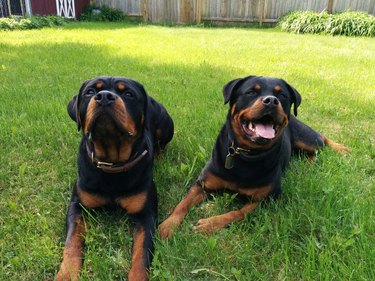The muscular, intelligent, and loyal Rottweiler expresses strength and power merely through his presence and stance. Dating back to the Middle Ages, the Rottweiler has earned his keep working as guard dog, police dog, livestock herder, messenger, and cart puller.

Recognized by the American Kennel Club in 1931, the Rottweiler is easily recognizable by his bulk and his dense, glossy black coat with rust-colored markings. Occasionally, these distinct markings are interrupted by white hairs or white markings on the chest. A Rottweiler with white fur is distinctive, but not breed standard.
Video of the Day
Video of the Day
Rottweiler white color
Once thought a sign of poor breeding, the white markings found on some Rottweilers' chests simply reflect the history of the Rottweiler. The appearance of white hairs originates from breeds such as the Bernese mountain dog and greater Swiss mountain dog, which were crossbred with mastiff-type dogs to create the original Rottweiler dog. These dogs had white chests — thus, so do some modern-day Rottweilers. Past Rottweilers could be found in a variety of color combinations including yellow and black, yellow and tan, red and tan, blue and tan, brindle, and solid black.
Rottweiler breed standard

Just as a person with two brown-haired parents might be born with blond hair as a genetic carryover from a relative far up on the family tree, so might a Rottweiler be born with white on his chest. Although these are attractive dogs, the breed standard set forth by the American Kennel Club penalizes Rottweilers with white markings.
The AKC breed standard clearly states that rust or mahogany markings must not be more than 10 percent of the coloring of the dog, and a white marking any place on the dog constitutes a serious fault. The standard clarifies that a few white hairs do not constitute a marking. While white hairs or white markings are most commonly seen on the chest, they appear occasionally on the face or head. However, German dog clubs call for the disqualification of a Rottweiler in the show ring exhibiting any white markings.
Rottweiler with white hair
While white markings on your Rottweiler don't constitute a health issue or indicate inadequate breeding, most responsible breeders will not offer AKC registration papers with full registration for a dog with them. Normally, the breeder will issue papers with limited registration, showing the dog is a purebred AKC-registered Rottweiler sold as a quality pet, not a quality show dog. A Rottweiler with white hair, or those who produce puppies with white markings, should not be bred if you're looking for a show dog.
White Rottweiler puppy

If you have a Rottweiler puppy with only a few white hairs on his chest, there's a good chance these hairs will fall out and be replaced with black hairs once his adult coat grows in. A full white Rottweiler puppy or Rottweiler puppy with white hair or markings, however, will likely remain white throughout the dog's lifetime. Regardless of color, the short smooth coat of the Rottweiler requires minimal grooming but does shed.